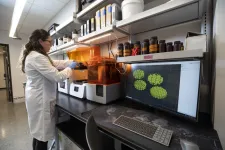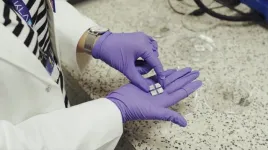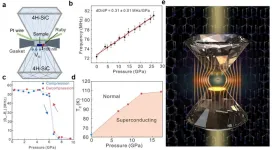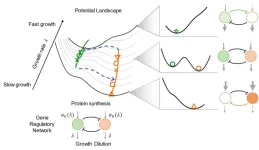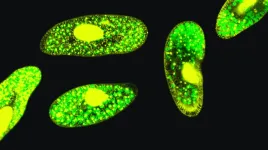(Press-News.org) ST. LOUIS – Research published in Environmental Research Letters has shown that methane emissions from urban areas are underestimated by a factor of three to four and that untreated wastewater may be a contributing factor.
The study, “Investigating high methane emissions from urban areas detected by TROPOMI and their association with untreated wastewater,” was led by Benjamin de Foy, Ph.D., professor of Earth and Atmospheric Sciences at Saint Louis University, and published online on March 14.
The researchers found that methane emissions from the discharge of untreated wastewater are a major contributor to global methane emissions and that improving wastewater treatment in urban areas could lead to a significant reduction in greenhouse gas emissions, helping cities on a quest for carbon neutrality.
“We estimate that reducing discharges of untreated wastewater could reduce global methane emissions by up to 5 to 10%,” said de Foy. “This could also yield significant ecological and human benefits.”
The two largest contributors to climate change are carbon dioxide and methane. In 2021, global methane concentrations increased at the highest rates on record and current estimates of methane emissions inventory cannot explain recent trends.
One method of evaluating methane emission is via satellite remote sensing, for example, with the TROPOspheric Monitoring Instrument (TROPOMI) on board the Sentinel 5 Precursor satellite. This has been measuring methane and other air pollutants all around the world since November 2017.
The research shows that methane emissions from urban areas may be underestimated by a factor of 3 to 4 in the Emissions Database for Global Atmospheric Research (EDGAR) greenhouse gas emission inventory. The study scaled the results to 385 urban areas worldwide with more than 2 million inhabitants each, suggesting that they could account for up to 22% of global methane emissions.
The emission estimates of the 61 urban areas do not correlate with the total or sectoral EDGAR emission inventory. They do however correlate with estimated rates of untreated wastewater, varying from 33 kg of methane per person per year for cities with zero untreated wastewater to 138 kg of methane per person per year for the cities with the most untreated wastewater.
The study looked at different scenarios for reducing emissions in the 61 urban areas, as well as for all areas with a population of more than 2 million. By reducing the emissions of the 33 cities with medium to high levels of untreated wastewater to the mean emissions of cities with zero to low untreated wastewater emissions, 2% of the worldwide emissions total could be cut. If all 61 cities reduced their emissions to the lowest rate, that would cut 6% of total worldwide methane emissions.
The researchers’ model points to untreated wastewater rather than other options, including natural gas leaks or older infrastructure, as a large share of overall methane emissions.
“Our estimates of methane emissions suggest that there is methane formation in the environment as a result of the release of untreated wastewater which is much larger than the estimates in current inventories,” said de Foy. “Some urban areas could reduce their emissions 50% or more by fully treating all their wastewater.”
The researchers say more work is needed to bridge the gap between inventories and measurements to create a more refined global emission inventory and identify more precisely the varying emissions from city to city. For example, cities in Europe and China emit much less methane than those in North America and Asia.
De Foy said that there can be large differences within countries, noting Milwaukee has a large methane enhancement but neighboring Minneapolis does not, which could be due to differences in how stormwater and sewage are handled.
One hundred fifty countries have committed to reducing their methane emissions by 30% by 2030 relative to 2020 as part of the Global Methane Pledge. Improved wastewater treatment could make a significant contribution to this goal.
Additional authors include James J. Schauer, Ph.D., the William C. Boyle Professor of Environmental Engineering and Director of the Wisconsin State Laboratory of Hygiene at the University of Wisconsin Madison; Alba Lorenete, Ph.D., research scientist, Netherlands Institute for Space Research (now at the Environmental Defense Fund); and Tobias Borsdorff, Ph.D., research scientist, Netherlands Institute for Space Research.
This work was partially supported by two grants from the United States Department of State (SMLAQM19CA2361 and SLMAQM20CA2398). TROPOMI data processing was carried out on the Dutch national e-infrastructure with the support of the SURF Cooperative.
Saint Louis University
Founded in 1818, Saint Louis University is one of the nation’s oldest and most prestigious Catholic institutions. Rooted in Jesuit values and its pioneering history as the first university west of the Mississippi River, SLU offers more than 13,500 students a rigorous, transformative education of the whole person. At the core of the University’s diverse community of scholars is SLU’s service-focused mission, which challenges and prepares students to make the world a better, more just place.
END
SLU research finds improved wastewater treatment could lead to significant reduction in greenhouse gas emissions
2023-03-23
ELSE PRESS RELEASES FROM THIS DATE:
What really matters in multi-story building design?
2023-03-23
The impact of multi-storey building design considerations on embodied carbon emissions, cost, and operational energy has been revealed for the first time.
Using a computer model, researchers estimate that up to six gigatonnes of carbon could be saved by 2050 if new multi-storey buildings follow certain recommendations during the design process. All these recommendations, which could also save between 28 and 44% of annual heating and cooling costs, use technology that is currently available.
Construction and operation of buildings account for more than one-third ...
UTEP joins project to 3D print batteries from lunar and Martian soil
2023-03-23
EL PASO, Texas (March 23, 2023) – The University of Texas at El Paso has joined a project led by NASA to leverage 3D-printing processes with the aim of manufacturing rechargeable batteries using lunar and Martian regolith, which is the top layer of materials that covers the surface of the moon and Mars.
“UTEP is a national leader in additive manufacturing for space applications,” said Kenith Meissner, Ph.D., dean of the UTEP College of Engineering. “I congratulate the team of UTEP researchers involved in this important work. I am confident their work will add significant value ...
For stressed-out grad students, mindfulness makes big difference
2023-03-23
MADISON – While recent studies and polls indicate the nation is in the midst of a mental health crisis, the situation in academia is even more grim: Within the high-stress, high-pressure, often socially isolated world of advanced education, graduate students experience depression and anxiety at six times the rate of the general population.
Normalizing mindfulness practices within the graduate student experience may be an answer, according to a three-year study conducted by University of Wisconsin–Madison ...
Alzheimer's early detection through biomarkers -
2023-03-23
Scientists from Swansea University ‘s Institute for Innovative Materials, Processing and Numerical Technologies (IMPACT) and Japan have been awarded £1.3 million to develop a new “point of care testing” kit that can detect biomarkers for Alzheimer's Disease.
The project follows Dr Sanjiv Sharma’s ground-breaking work in this area and the development of the world’s first COVID-19 ‘smart patch’.
Compared to hypodermic single needles, a ‘smart patch’ consists of a collection of tiny needles - microneedles - created to break the skin barrier in a minimally invasive ...
Rates of autism climb to new highs in the U.S., with California setting record numbers
2023-03-23
New federal studies coauthored by autism experts at Rutgers found that more children have been diagnosed with autism than at any time since monitoring began more than two decades ago.
According to the U.S. Centers for Disease Control and Prevention (CDC), about 4 percent of 8-year-old boys and 1 percent of 8-year-old girls, have autism in the U.S. These estimates are the highest since the CDC’s Autism and Developmental Disabilities Monitoring (ADDM) Network was created in 2000.
Biennial studies from the ADDM Network, which analyzed ...
Study uncovers aspect of how muscular dystrophies progress
2023-03-23
A research study has shed new light on how congenital muscular dystrophies such as Walker-Warburg syndrome progress, bringing hope for better understanding, early diagnosis and treatments of these fatal disorders.
Published in March in the Journal of Biological Chemistry, the research was led by scientists in the lab of Vlad Panin, Ph.D., professor in the Department of Biochemistry and Biophysics in the Texas A&M College of Agriculture and Life Sciences. The study is titled “Protein tyrosine phosphatase 69D is a substrate of protein O-mannosyltransferases 1-2 that is required for the wiring of sensory axons in Drosophila.” ...
Researchers make breakthrough in high-pressure magnetic detection
2023-03-23
According to a study published in Nature Materials, a collaborative research team from the Hefei Institutes of Physical Science of the Chinese Academy of Sciences (CAS) and the University of Science and Technology of China has developed a research platform to study superconducting magnetic detection and magnetic phase transitions of hydrides under high pressure.
High-resolution in-situ magnetic measurement under high pressure has been a challenge. It has limited the progress of research on the Meissner effect of superconductivity and on magnetic phase transition behavior under high pressure. Using the optically detected ...
Cellular growth rate reshapes cell-fate-decision landscape
2023-03-23
Genes and the regulation relationships among them create complex networks that determine cell differentiation trajectories. However, we still cannot understand and predict the cell-fate-decision process using network topology in a bottom-up manner.
Recently, a research group led by Prof. FU Xiongfei from the Shenzhen Institute of Advanced Technology (SIAT) of the Chinese Academy of Sciences (CAS) has revealed how the global regulation factor, cellular growth rate, reshapes the cell-fate-decision landscape.
The ...
Where does your brain want to have lunch?
2023-03-23
New research published by investigators at Cedars-Sinai advances scientific understanding of how the brain weighs decisions involving what people like or value, such as choosing which book to read, which restaurant to pick for lunch—or even, which slot machine to play in a casino. Published today in the peer-reviewed journal Nature Human Behaviour, this study involved recording the activity of individual human neurons.
The study examined decisions called value-based choices, where there is ...
Microplastics limit energy production in tiny freshwater species
2023-03-23
Microplastic pollution reduces energy production in a microscopic creature found in freshwater worldwide, new research shows.
Paramecium bursaria contain algae that live inside their cells and provide energy by photosynthesis.
The new study, by the University of Exeter, tested whether severe microplastic contamination in the water affected this symbiotic relationship.
The results showed a 50% decline in net photosynthesis – a major impact on the algae’s ability to produce energy and release ...
